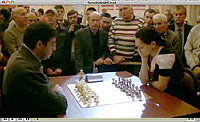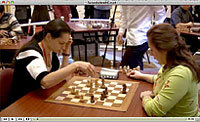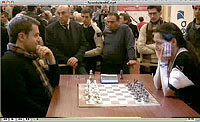GM Nielsen protests about rating calculations at European Individual Chess Championship 2011
Chess blog for latest chess news and chess trivia (c) Alexandra Kosteniuk, 2011
Hi everyone,
Grandmaster Peter Heine Nielsen has written to the European Union protesting the rating calculations that were carried out at the recently-concluded European Individual Championships to ascertain the list of players who would qualify for the upcoming World Cup of Chess. Here is the text of his letter.
To the European Chess Union
As a participant of the 2011 European Individual Championship, I, Peter Heine Nielsen, hereby protest against the final standing.
Claim:
Primary: The Performance Rating for players with the same number of points in the 2011 European Individual Championship must be recalculated in such a way, that the highest and lowest opponent’s Elo rating is excluded when calculating the opponents’ average rating, but points achieved against these two players are included when calculating the percentage score. The final standing must be corrected in accordance to the recalculated tie-break.
Secondary: Proper compensation given to me and other participants of this ECU tournament, who have been harmed by the implementation of the Performance Rating.
The tie-breaking was not calculated from the actual score in the tournament but from only a selected number of games. As a consequence the crucial numbers defining the finishing position for players with equal score in points was in no way the Performance Ratings for the results in the tournament as stated in the regulations.
The scoring and tie-breaking system applied in the European Championship that took place March 21st – April 2nd in Aix-les-Bains is published in ECU regulations and described as follows:
6.1 The score in each game is 1 for a win, ½ for a draw and 0 for a lost game.
6.2 Tie-breaking in individual competitions.
The order of players that finish with the same number of points shall be determined by application of the following tie-breaking procedures in sequence, proceeding from (a) to (b) to (c) to (d) the extent required:
(a) Performance Rating
(b) Median-Buchholz 1, the highest number wins;
(c) Buchholz, the highest number wins;
(d) Number of wins, the highest number wins.
In case of (a) the highest and the lowest rated opponent will be deleted and the maximum rating difference of two players shall be 400 points.
In the case of unplayed games for the calculation of (a), (b) and (c) the current FIDE Tournament Rules shall be applied.
I argue that “In case of (a) the highest and the lowest rated opponent will be deleted” should be interpreted such as the rating of these opponents shall not be included when calculating the average rating of the opponents, but such as the points scored against them shall be included when calculating the procentual score.
The second part of the section “... and the maximum rating difference of two players shall be 400 points” is also open for two interpretations: Either such as a game against an opponent, where the difference exceeds 400 points is to be deleted before calculating both the average rating and the procentual score, or such as the opponent shall be corrected to the fictitious rating diference 400 points before calculating the average rating, while the result in the game counts when calculating the procentual score. It is worth noticing, that the interpretation of the first and the second part of the section goes into opposite directions in the implementation used for the 2011 European Individual Championship.
Implementation of tie-break rule 6.2 (a), by deleting the highest and the lowest rated player before calculating the average rating used for Performance Rating, would still make it a Performance Rating for the full tournament. And this is what I, and probably the ECU General Assembly, the ACP and most of my chess-playing colleagues expected from the text. However by deleting not only the rating of the opponent but also the obtained score against them, the calculated Performance Rating counts only the performance in nine selected games and can not - mathematically, legally or in any reasonable interpretation – be accepted as the tie-breaking relevant Performance Rating in the full tournament.
Using some examples I shall prove that the ECU Performance Rating in the way the regulation 6.2 (a) is interpreted by the tournament administrators is nothing else but FIDE Performance Rating for selected nine games, while counting two of the eleven valid games as not played. These examples will reveal that by deleting the results of the two games, the system of tie-break is changed so drastically, that it cannot be called Performance Rating for the tournament as stated by 6.2 (a).
Example 1:
Mircea-Emilian Parligras scored 7½ points in 11 games. In this example I compare the FIDE Performance Rating system with the system implemented in the 2011 European Individual Championship (below called EC 2011 “Performance” Rating).
Parligras’ FIDE Performance Rating is calculated as his opponents’ average rating for the whole tournament, plus the added bonus for his percentage score for the whole tournament. Parligras’ Performance for the full 11-round tournament is his opponents’ average rating 2602 plus 133 points added for his 68% score resulting in a FIDE Performance Rating of 2735.
His EC 2011 “Performance” Rating is calculated exactly as a FIDE Performance Rating, just with two results crossed out (in this case two victories!). It gives him the average rating of 2629 for the 9 games plus an 80 point bonus for a 61% score in these 9 games. Therefore his EC 2011 “Performance” Rating is 2709.
Conclusion: In reality EC 2011 “Performance” Rating just shows Parligras’ FIDE Performance Rating for 9 selected games in a 11 round tournament.
Example 2:
For a system to be described as Performance Rating it must have certain attributes:
A) As the most fundamental attribute it is obvious that two players with the same rating, playing the same opponents, making the same number of points, hold the same Performance Rating.
B) Lowering the rating of a specific opponent should never result in improving one’s Performance Rating.
However, as demonstrated below, the implementation of the system in the 2011 European Championship did not fulfil these mandatory criteria.
‘Player 1’ and ‘Player 2’ have the same rating and both players have played 11 games against the very same 11 opponents, both scoring 9 points against an average of 2500, having played 1 opponent rated 2400, 9 rated 2500 and 1 rated 2600.
However their EC 2011 “Performance” Rating is strikingly different:
‘Player 1’ scoring 9 points in 9 games: EC 2011 “Performance” Rating = 3300
‘Player 2’ scoring 7 points in 9 games: EC 2011 “Performance” Rating = 2762
Conclusion: A difference of 538 points calculated for two absolutely identical tournament results proves that the EC 2011 interpretation of Rating Performance does not fulfil the most fundamental criteria (A) of a Performance Rating system.
B) Here I shall use the example from my own tournament:
From Alexandra Kosteniuk's
www.chessblog.com
Also see her personal blog at
www.chessqueen.com
Hi everyone,
Grandmaster Peter Heine Nielsen has written to the European Union protesting the rating calculations that were carried out at the recently-concluded European Individual Championships to ascertain the list of players who would qualify for the upcoming World Cup of Chess. Here is the text of his letter.
To the European Chess Union
As a participant of the 2011 European Individual Championship, I, Peter Heine Nielsen, hereby protest against the final standing.
Claim:
Primary: The Performance Rating for players with the same number of points in the 2011 European Individual Championship must be recalculated in such a way, that the highest and lowest opponent’s Elo rating is excluded when calculating the opponents’ average rating, but points achieved against these two players are included when calculating the percentage score. The final standing must be corrected in accordance to the recalculated tie-break.
Secondary: Proper compensation given to me and other participants of this ECU tournament, who have been harmed by the implementation of the Performance Rating.
The tie-breaking was not calculated from the actual score in the tournament but from only a selected number of games. As a consequence the crucial numbers defining the finishing position for players with equal score in points was in no way the Performance Ratings for the results in the tournament as stated in the regulations.
The scoring and tie-breaking system applied in the European Championship that took place March 21st – April 2nd in Aix-les-Bains is published in ECU regulations and described as follows:
6.1 The score in each game is 1 for a win, ½ for a draw and 0 for a lost game.
6.2 Tie-breaking in individual competitions.
The order of players that finish with the same number of points shall be determined by application of the following tie-breaking procedures in sequence, proceeding from (a) to (b) to (c) to (d) the extent required:
(a) Performance Rating
(b) Median-Buchholz 1, the highest number wins;
(c) Buchholz, the highest number wins;
(d) Number of wins, the highest number wins.
In case of (a) the highest and the lowest rated opponent will be deleted and the maximum rating difference of two players shall be 400 points.
In the case of unplayed games for the calculation of (a), (b) and (c) the current FIDE Tournament Rules shall be applied.
I argue that “In case of (a) the highest and the lowest rated opponent will be deleted” should be interpreted such as the rating of these opponents shall not be included when calculating the average rating of the opponents, but such as the points scored against them shall be included when calculating the procentual score.
The second part of the section “... and the maximum rating difference of two players shall be 400 points” is also open for two interpretations: Either such as a game against an opponent, where the difference exceeds 400 points is to be deleted before calculating both the average rating and the procentual score, or such as the opponent shall be corrected to the fictitious rating diference 400 points before calculating the average rating, while the result in the game counts when calculating the procentual score. It is worth noticing, that the interpretation of the first and the second part of the section goes into opposite directions in the implementation used for the 2011 European Individual Championship.
Implementation of tie-break rule 6.2 (a), by deleting the highest and the lowest rated player before calculating the average rating used for Performance Rating, would still make it a Performance Rating for the full tournament. And this is what I, and probably the ECU General Assembly, the ACP and most of my chess-playing colleagues expected from the text. However by deleting not only the rating of the opponent but also the obtained score against them, the calculated Performance Rating counts only the performance in nine selected games and can not - mathematically, legally or in any reasonable interpretation – be accepted as the tie-breaking relevant Performance Rating in the full tournament.
Using some examples I shall prove that the ECU Performance Rating in the way the regulation 6.2 (a) is interpreted by the tournament administrators is nothing else but FIDE Performance Rating for selected nine games, while counting two of the eleven valid games as not played. These examples will reveal that by deleting the results of the two games, the system of tie-break is changed so drastically, that it cannot be called Performance Rating for the tournament as stated by 6.2 (a).
Example 1:
Mircea-Emilian Parligras scored 7½ points in 11 games. In this example I compare the FIDE Performance Rating system with the system implemented in the 2011 European Individual Championship (below called EC 2011 “Performance” Rating).
Round 1 2236 1Round 2 Round 3 2729 1Round 4 Round 5 Round 6 Round 7 Round 8 Round 9 Round 10 Round 11
Average rating: 2602
FIDE Performance = 2735
Average rating: 2629
EC 2011 “Performance” = 2709
Parligras’ FIDE Performance Rating is calculated as his opponents’ average rating for the whole tournament, plus the added bonus for his percentage score for the whole tournament. Parligras’ Performance for the full 11-round tournament is his opponents’ average rating 2602 plus 133 points added for his 68% score resulting in a FIDE Performance Rating of 2735.
His EC 2011 “Performance” Rating is calculated exactly as a FIDE Performance Rating, just with two results crossed out (in this case two victories!). It gives him the average rating of 2629 for the 9 games plus an 80 point bonus for a 61% score in these 9 games. Therefore his EC 2011 “Performance” Rating is 2709.
Conclusion: In reality EC 2011 “Performance” Rating just shows Parligras’ FIDE Performance Rating for 9 selected games in a 11 round tournament.
Example 2:
For a system to be described as Performance Rating it must have certain attributes:
A) As the most fundamental attribute it is obvious that two players with the same rating, playing the same opponents, making the same number of points, hold the same Performance Rating.
B) Lowering the rating of a specific opponent should never result in improving one’s Performance Rating.
However, as demonstrated below, the implementation of the system in the 2011 European Championship did not fulfil these mandatory criteria.
Round 1 2400 0Round 2 2400 1Round 3 Round 4 Round 5 Round 6 Round 7 Round 8 Round 9 Round 10 2600 1Round 11 2600 0
‘Player 1’ and ‘Player 2’ have the same rating and both players have played 11 games against the very same 11 opponents, both scoring 9 points against an average of 2500, having played 1 opponent rated 2400, 9 rated 2500 and 1 rated 2600.
However their EC 2011 “Performance” Rating is strikingly different:
‘Player 1’ scoring 9 points in 9 games: EC 2011 “Performance” Rating = 3300
‘Player 2’ scoring 7 points in 9 games: EC 2011 “Performance” Rating = 2762
Conclusion: A difference of 538 points calculated for two absolutely identical tournament results proves that the EC 2011 interpretation of Rating Performance does not fulfil the most fundamental criteria (A) of a Performance Rating system.
B) Here I shall use the example from my own tournament:
Round 1 2385 1Round 2 Round 3 Round 4 Round 5 Round 6 Round 7 Round 8 Round 9 Round 10 2729 ½2729 ½Round 11 1200 ½
Average rating: 2578
EC 2011 “Performance” = 2703
Average rating: 2551
EC 2011 “Performance” Rating = 2717
The first column is my actual tournament. In the second column I repeat the first 10 games in my tournament, but with my last round opponent replaced by a player rated as low as 1200. 1200 could be 2384 or anything in between as well.
Calculated according to the EC 2011 “Performance” Rating system, my Performance Rating rises 14 points (enough for qualification) by lowering my last round opponent’s rating from 2626 to 1200. This is due to the fact that despite scoring the same number of points in the overall tournament, the EC 2011 “Performance” Rating will be calculated with a higher percentage score, as now I have only 1 point removed from my score, not 1½.
Conclusion: Lowering the rating of a specific opponent improved the EC 2011 “Performance” Rating, which proves that the EC 2011 interpretation does not fulfil the fundamental criteria (B) to be an approvable Performance Rating system.
The examples showing absurd results as a consequence of using the EC 2011 “Performance” Rating are numerous. One of the most extreme cases is that of Paligras. The reason he did not qualify for the World Cup, was not because he lost the final round, but because he lost it to a high rated opponent! He was paired against Jakovenko rated 2719. In his situation the solution was to default the game or violate the zero tolerance rule. Then the game would have been counted as his lowest rated, and Parligras would have improved his EC 2011 “Performance” Rating more than enough to qualify for the World Cup!
The above given examples 1) and 2) are more than sufficient to prove, that the EC 2011 implementation does notmatch the standard of Performance Rating which is expected from the tournament regulations and does not calculate on the relevant number of games but leads to wrong, unfair and misleading tie-breaking results.
I therefore claim that: primarily the final standings of the 2011 European Championship to be based on a fair tie-break according to the regulations interpreted in accordance with what I wrote at the bottom of page 1, secondarily call for proper compensation given to me and other participants of this ECU tournament who have been harmed by the EC 2011 implementation of the Performance Rating.
For further comments on intentions, correspondence, interpretentions and timing please read the Enclosure.
Århus, the 10th of April 2011
Peter Heine Nielsen
| Tweet |
From Alexandra Kosteniuk's
www.chessblog.com
Also see her personal blog at
www.chessqueen.com
Labels: chess blog, European Individual Chess Championship, peter heine nielsen, protest




































0 Comments:
Post a Comment
Note: Only a member of this blog may post a comment.
Subscribe to Post Comments [Atom]
<< Home